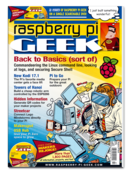Building Rasp Pi into Mindstorms projects with BrickPi
It would be a mistake to dismiss Mindstorms as a child's toy just because it is made by Lego. When he was in college, Google co-founder Larry Page built a functioning ink jet printer out of Mindstorms parts and related accessories. All over the world, tinkerers are expanding the capabilities of Lego robots by hooking several Lego NXT control modules together or connecting them to a PC via Bluetooth to access PC storage space. A doctoral student from London has even combined Mindstorms elements with other modules and other components produced by a 3D printer to make a functioning atomic microscope.
Lego published the first version of Mindstorms in 1998. At that time, the only goal envisioned for the product was to better acquaint young people with the subject of robotics. However, the system quickly became so popular that the manufacturers began to include it in their general product line. These build-it-yourself robots have now become a part of the curriculum at many universities.
The benefit of Mindstorms is in the hardware. Even in the absence of extensive background knowledge, a user can experience success simply by plugging the parts together. Mindstorms parts from the Lego Technic and Lego System series aren't the large blocks you remember from preschool. In addition to the blocks and moving parts, servo motors and numerous sensors deal with sound, color, ultrasound, touch, and temperature. The goal is to dock all of these components onto other building blocks and connect them via cable to the socket of a large, central control module that makes CPU, memory, and interfaces available.
[...]
Buy this article as PDF
Pages: 4
(incl. VAT)







